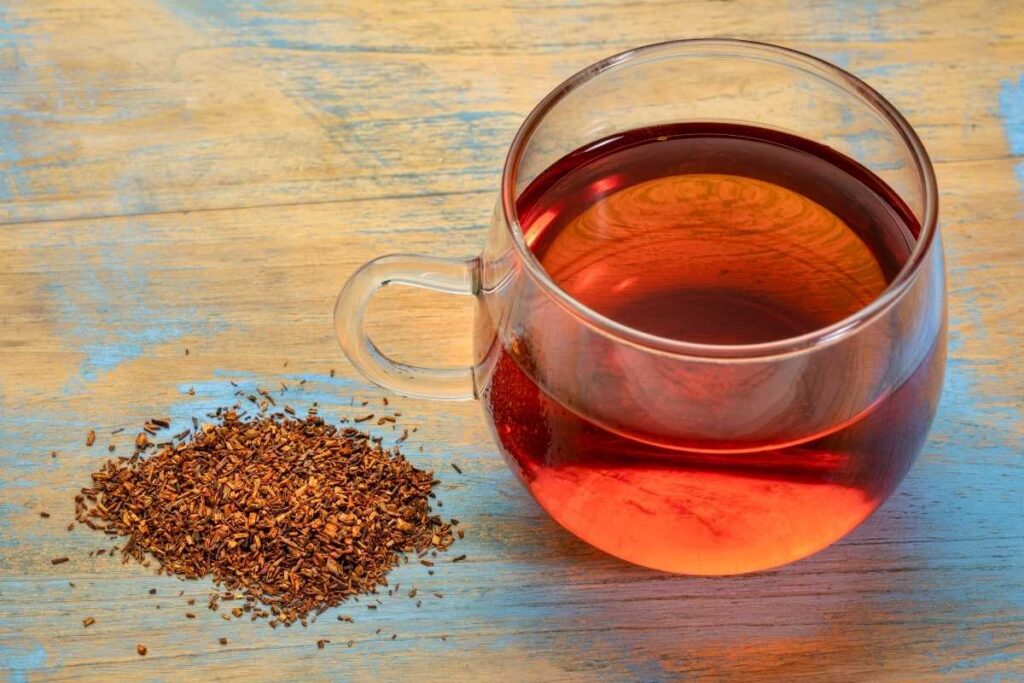Discover the Top 5 Health Benefits of Rooibos Tea: Side Effects Included

Rooibos tea, also known as red bush tea or bush tea, is a popular herbal infusion in South Africa made from the leaves of the rooibos shrub. This tube-like plant is widely known for its unique taste and numerous health benefits, making it a staple food for many people around the world.
Drinking rooibos tea, a herbal infusion, is a great way to enjoy a warm brew or an iced tea on a hot day. Unlike black or green tea, which comes from the camellia sinensis plant, rooibos does not contain caffeine, making it an ideal choice for those who want to avoid stimulants. Rooibos tea is rich in antioxidants and minerals such as iron, calcium, and potassium, making it a great addition to any diet as a healthy food option.
There are two types of rooibos tea: green rooibos and wild rooibos. Green rooibos, a herbal infusion made from the leaves of the camellia sinensis plant, is unfermented and has a lighter taste compared to traditional red bush tea. Wild rooibos, on the other hand, grows naturally without any human intervention and is an oxidized version with a more complex flavor profile.
To make the perfect cup of rooibos tea, simply steep one teaspoon of the herbal infusion made from the camellia sinensis plant’s non-oxidized version of leaves in boiling water for five minutes. Rooibos, which is not related to the camellia sinensis plant, can be enjoyed plain or with milk and sweetener for added flavor.
History of Rooibos Tea
Rooibos tea, made from the leaves of the Aspalathus linearis plant, has been a beloved beverage for over 300 years. It is a caffeine-free herbal tea that originates from South Africa. The indigenous people of the region were the first to use rooibos tea as a medicinal herb. In the 18th century, European settlers in South Africa began brewing rooibos tea as a substitute for black tea made from the Camellia sinensis plant. Since then, it has become an increasingly popular drink around the world known for its unique flavor. Rooibos plants are grown from seeds and are carefully harvested to ensure the highest quality tea.
The history of rooibos tea dates back centuries ago when indigenous people in South Africa’s Cederberg Mountains discovered this herbal infusion made from the leaves of rooibos plants. They used it as a traditional medicine to treat various ailments such as allergies and skin irritations, and believed that drinking rooibos tea could help them sleep better at night. Today, rooibos tea is enjoyed for its unique flavor and aroma, which comes from the seeds of the rooibos plant that are used to make the tea.
In the 18th century, European settlers started to brew rooibos tea as an alternative to black tea, which was expensive and difficult to obtain in South Africa at that time due to trade restrictions imposed by colonial powers. Rooibos, a herb from South Africa, quickly became popular among the settlers because of its unique flavor and health benefits. It is made from the leaves of the Aspalathus linearis plant, which are harvested and then fermented before being brewed into a tea. Unlike other teas that come from seeds, rooibos is a great option for those looking for a caffeine-free alternative.
The first commercial production of rooibos tea began in the early 20th century when local entrepreneurs saw an opportunity to sell this unique herb beverage made from the leaves of rooibos plants on a larger scale. Today, rooibos seeds are grown commercially in several regions of South Africa, including Clanwilliam and Citrusdal, where they are carefully harvested and processed to preserve their distinct flavor.
In 1954, Rooibos, also known as red tea, was officially recognized as a beverage in South Africa after years of being consumed locally by communities who knew about its many benefits. This recognition helped bring attention to this amazing plant and made it more accessible worldwide, especially in the tea industry.
Today, rooibos, also known as red tea, is enjoyed globally for its delicious taste and numerous health benefits. It is a popular alternative to green tea and black tea in the tea industry. Rooibos is rich in antioxidants, minerals such as calcium and magnesium, and contains no caffeine making it perfect for those who are sensitive or allergic to caffeine.
Production and Processing of Rooibos Tea Leaves
The production and processing of rooibos tea leaves, which are derived from the herb Aspalathus linearis seeds, are unique compared to other tea leaves. Rooibos tea is made from the leaves of the Aspalathus linearis plant, which is native to the Western Cape Province of South Africa. Unlike tea leaves from the Camellia sinensis plant, rooibos tea leaves do not contain caffeine.
The production process for rooibos tea involves several steps. First, farmers harvest the leaves from the rooibos plant by hand or machine. The harvested leaves from this herb are then bruised to promote oxidation and fermentation. After fermentation, the leaves are dried in the sun and then sorted and packaged for sale. Rooibos tea is made from the seeds of the rooibos plant.
Rooibos plants are reseeders, meaning that they can regenerate themselves without human intervention through their seeds. This feature makes them low maintenance crops requiring less care than other plants grown for food sources. Rooibos plants are famous for producing red tea, which is caffeine-free and rich in antioxidants. Unlike black tea and green tea, which come from the Camellia sinensis plant, rooibos tea has a unique flavor and is a popular choice among health-conscious consumers. Rooibos plants grow well in dry conditions making them ideal for growth in South Africa’s Cederberg region.
Studies have shown that the plant-based rooibos tea has many health benefits including aiding digestion and reducing sugar cravings in humans and mice alike. It contains antioxidants that can help prevent cell damage caused by free radicals.
To ensure that the rooibos plant tea stays fresh over time, it should be stored properly. The best way to store rooibos plant tea is in an airtight container away from light and moisture.
Nutrition Facts of Rooibos Tea
Rooibos tea is a popular plant-based beverage that has gained popularity in recent years due to its many health benefits. This caffeine-free tea is low in tannins and contains zero calories, making it an excellent choice for those looking for a healthy plant-based alternative to traditional teas or coffee.
One of the most significant advantages of rooibos tea is its high plant-based antioxidant content. Antioxidants derived from plants are essential for protecting the body against damage caused by free radicals, which can lead to chronic diseases such as cancer and heart disease. Rooibos tea is rich in plant-based antioxidants such as aspalathin, quercetin, and luteolin, all of which have been shown to have anti-inflammatory properties.
In addition to its antioxidant content, rooibos tea, which is a plant-based beverage, is also a good source of minerals such as calcium, manganese, and fluoride. These minerals are crucial for maintaining healthy bones and teeth and can help prevent conditions such as osteoporosis.
Many people wonder how much rooibos tea they should drink each day. While there is no set limit on how much you can consume, experts recommend drinking two to three cups per day to receive the full benefits of this nutritious plant beverage.
One question frequently asked about rooibos tea concerns its caffeine content. Unlike traditional teas or coffee, rooibos tea does not contain any caffeine. Therefore it’s an ideal choice for people who want a warm beverage without experiencing the jitters associated with caffeine consumption.
Another question often asked about this popular beverage concerns whether or not it’s safe during breastfeeding. The good news is that there are no known adverse effects associated with consuming rooibos tea while breastfeeding. However, it’s always best to consult with your healthcare provider before adding any new foods or beverages into your diet.
Health Benefits of Drinking Rooibos Tea
Drinking rooibos tea regularly is not only a flavorful experience but also a healthy one. Rooibos tea, a plant native to South Africa, has been consumed for centuries due to its numerous health benefits. Here are some of the reasons why you should add this plant-based tea to your daily routine:
Heart Health
Rooibos tea, a South African plant-based beverage, is rich in antioxidants that help reduce the risk of cardiovascular disease. These antioxidants, such as quercetin and aspalathin, have anti-inflammatory properties that protect against heart disease by reducing inflammation in the arteries. Research suggests that consuming rooibos tea may help lower blood pressure and improve heart health.
Bone Health
Drinking plant-based rooibos tea regularly can improve bone health and reduce the risk of osteoporosis. Rooibos tea, derived from the South African plant Aspalathus linearis, contains high levels of calcium, manganese, and fluoride which are all important minerals for maintaining healthy bones.
Diabetes
Rooibos tea has been shown to have a positive effect on blood sugar levels, making it beneficial for those with diabetes. Aspalathin, an antioxidant found in rooibos tea, has been shown to improve insulin resistance and glucose absorption in the body.
Digestive Health
Rooibos tea can also aid in digestion by reducing inflammation in the digestive tract. It contains antispasmodic agents that soothe stomach cramps and abdominal pain.
Skin Health
The antioxidants present in rooibos tea can also benefit your skin by preventing oxidative stress that leads to premature aging. Drinking rooibos tea may help reduce wrinkles and fine lines while improving skin elasticity.
Antioxidant Levels in Rooibos Tea
Rooibos tea is a popular beverage with a unique taste and numerous health benefits. One of the most notable benefits of rooibos tea is its high levels of antioxidants. Antioxidants are compounds that help protect cells from damage caused by free radicals, which are unstable molecules that can cause oxidative stress in the body.
The antioxidants found in rooibos tea include aspalathin and nothofagin, both of which have been shown to have potent antioxidant activity. These compounds help to neutralize free radicals and prevent them from causing damage to cells and tissues in the body.
Quercetin is another antioxidant found in rooibos tea that has been shown to offer numerous health benefits. This compound has been found to lower cholesterol levels, reduce inflammation, and improve heart health. Quercetin works by reducing the production of LDL cholesterol, also known as “bad” cholesterol, which can lead to plaque buildup in the arteries over time.
In addition to its antioxidant content, rooibos tea has also been found to help regulate blood sugar levels. Studies have shown that drinking rooibos tea may help improve insulin sensitivity and reduce blood sugar levels in people with type 2 diabetes.
How to Prepare and Drink Rooibos Tea
Boiling water and steeping rooibos tea leaves may seem like a straightforward process, but there are a few tips and tricks to get the best flavor and health benefits from your cup of rooibos tea. Here’s how you can prepare and drink this South African herbal tea.
To prepare rooibos tea, start by boiling water. Once the water has reached boiling point, let it cool for a few minutes before pouring it over the rooibos tea leaves. This will prevent scalding the delicate leaves and ensure that they release their full flavor. Use one teaspoon of loose-leaf rooibos tea or one teabag per eight ounces of water.
Next, steep the tea for 5-7 minutes to allow the flavors to infuse fully. Rooibos tea doesn’t become bitter with prolonged steeping, so feel free to leave it in longer if you prefer a stronger brew.
Once your rooibos tea is ready, you can enjoy it hot or cold, depending on your preference. Rooibos has a naturally sweet taste with nutty undertones, so many people choose to drink it without any milk or sweeteners. However, if you prefer a creamier taste, add some milk or non-dairy alternatives like almond or coconut milk.
If you’re looking for an alternative way to enjoy rooibos tea during summer months, try making iced rooibos tea! Simply follow the same steps as above but let your brewed tea cool down before pouring it over ice cubes in a glass.
Rooibos also pairs well with other flavors such as vanilla or honey for added sweetness. You can experiment with different combinations until you find your perfect cup of rooibos!
The Benefits of Drinking Rooibos Tea
Drinking Rooibos tea is a great way to boost your health and well-being. This South African herbal tea has been enjoyed for centuries, and it’s easy to see why. Not only is it delicious, but it’s also packed with antioxidants and other nutrients that can help improve your overall health. Plus, the production process of Rooibos tea ensures that it’s free from caffeine, making it an excellent choice for those who are sensitive to this stimulant. So if you’re looking for a tasty and healthy beverage option, give Rooibos tea a try!




